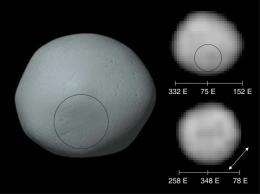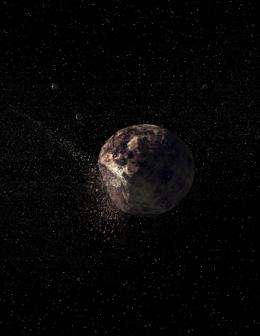Study of first high-resolution images of Pallas confirms asteroid is actually a protoplanet

(PhysOrg.com) -- Britney E. Schmidt, a UCLA doctoral student in the department of Earth and space sciences, wasn't sure what she'd glean from images of the asteroid Pallas taken by the Hubble Space Telescope. But she hoped to settle at least one burning question: Was Pallas, the second-largest asteroid, actually in that gray area between an asteroid and a small planet?
The answer, she found, was yes. Pallas, like its sister asteroids Ceres and Vesta, was that rare thing: an intact protoplanet.
"It was incredibly exciting to have this new perspective on an object that is really interesting and hadn't been observed by Hubble at high resolution," Schmidt said of the first high-resolution images of Pallas, which is believed to have been intact since its formation, most likely within a few million years of the birth of our solar system.
"We were trying to understand not only the object, but how the solar system formed," Schmidt said. "We think of these large asteroids not only as the building blocks of planets but as a chance to look at planet formation frozen in time."
The research appears Oct. 9 in the journal Science.
"To have the chance to use Hubble at all, and to see those images come back and understand automatically this could change what we think about this object — that was incredibly exciting to me," Schmidt said.
Pallas, which is named for the Greek goddess Pallas Athena, lies in the main asteroid belt between the orbits of Jupiter and Mars. Schmidt likens it to the size of Arizona, her home state. The massive body is unique, she said, partly because "its orbit is so much different from other asteroids. It's highly inclined."
Hubble had tried to snap pictures of the round-shaped body before but came up short. So when the space telescope took images again in September 2007, Schmidt and her colleagues had several goals.

"We wanted to learn about Pallas itself — what its shape is like, what its surface is like, does it have large impact craters, does it have significant topography,” she said.
With the Hubble images, Schmidt and her colleagues were able to take new measurements of Pallas' size and shape. They were able to see that its surface has areas of dark and light, indicating that the water-rich body might have undergone an internal change in the same way planets do.
Pallas wasn't just a big rock made of hydrated silicate and ice, they found.
"That's what makes it more like a planet — the color variation and the round shape are very important as far as understanding, is this a dynamic object or has it been exactly the same since it's been formed?" Schmidt said. "We think it's probably a dynamic object."
For the first time, Schmidt and her colleagues also saw a large impact site on Pallas. They were unable to determine if it was a crater, but the depression did suggest something else important: that it could have led to Pallas' small family of asteroids orbiting in space.
"It's interesting, because there are very few large, intact asteroids left," Schmidt said. "There were probably many more. Most have been broken up completely. It's an interesting chance to almost look into the object, at the layer underneath. It's helping to unravel one of the big questions that we have about Pallas, why does it have this family?"
Schmidt's co-authors include Peter C. Thomas, a senior researcher at Cornell University; James Bauer, a researcher with the Jet Propulsion Laboratory; J.Y. Li, a postdoctoral student at the University of Maryland; Schmidt's Ph.D. adviser, UCLA professor of geophysics and space physics Christopher T. Russell; Andrew Rivkin, a researcher at Johns Hopkins University; Joel William Parker, a researcher at the Southwest Research Institute in Boulder, Colorado; Lucy McFadden, a faculty member at the University of Maryland; S. Alan Stern of the Southwest Research Institute; Max Mutchler, a researcher at the Space Telescope Sciences Institute; and Chris Radcliffe, a digital artist in Santa Monica.
"When people think of asteroids, they think of 'Star Wars' or of tiny little rocks floating through space," Schmidt said. "But some of these have been really physically dynamic. Around 5 million years after the formation of the solar system, Pallas was probably doing something kind of interesting."
More information: Research paper in Science.
Provided by University of California Los Angeles (news : web)


















